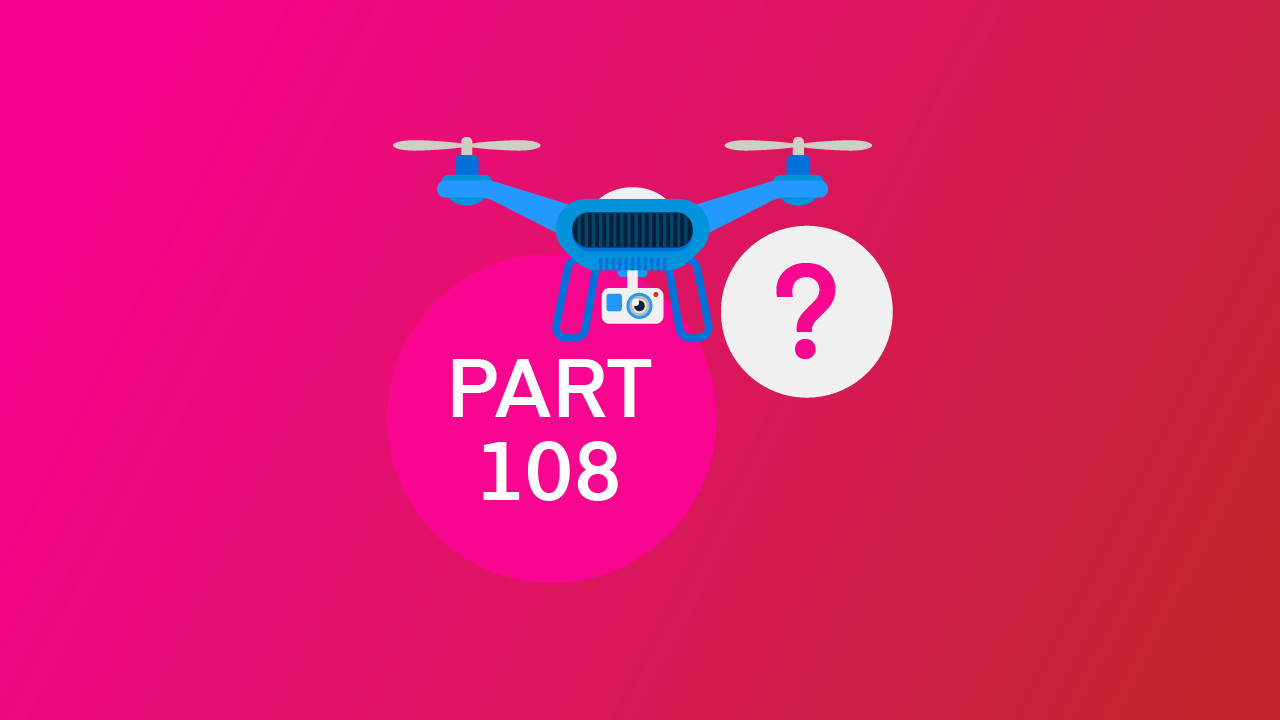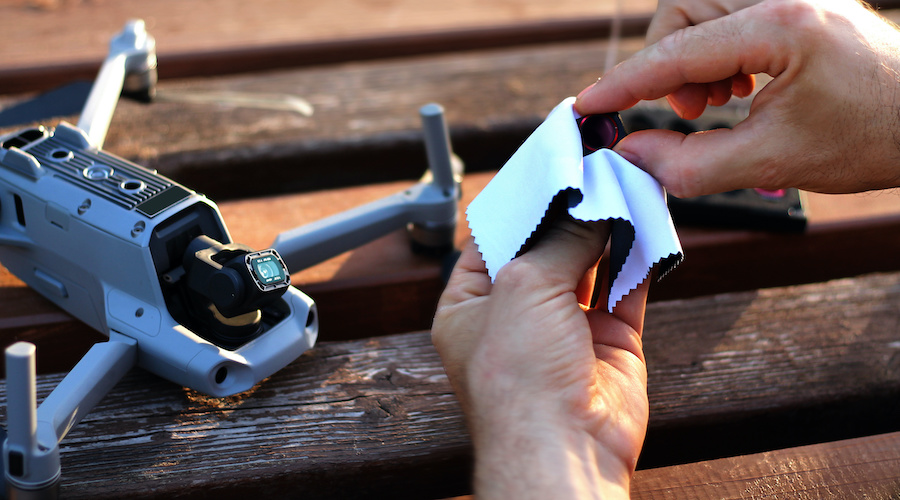-
Key Takeaways
-
What Is Part 108?
- The Difference Between Part 107 and Part 108
-
Regulatory Changes Connected to Part 108
- Part 89 (Remote ID) Requirements
- Part 48 (Registration) Updates
- What No Longer Applies to Part 107
-
Key Players and Roles
- Operator
- Operations Supervisor
- Flight Coordinator
- Other Operational Staff
- FAA & TSA Oversight
- Manufacturers
- Automated Data Service Providers (ADSP)
-
New Terms and Core Concepts
- Airworthiness Acceptance
- Operational Intent
- Detect-and-Avoid and Strategic Conflict Detection
- Target Average Conformance and Conformance Monitoring
-
Operations and Personnel Requirements
- Duty/Rest Rules (§108.330)
- Recordkeeping & Reporting Requirements (§108.45)
- Operations Manual
-
Right-of-Way Rules
-
Shielded Operations (§108.205)
-
Population Density Categories
-
Permitted vs. Certificated Operations
- Permitted Operations
- Certificated Operations
-
Aircraft Design & Safety Requirements
-
Maintenance and Repairs
-
Testing & Quality Assurance
-
Future FAA Rulemaking
-
Conclusion
Today, a pipeline operator has to juggle 20 separate BVLOS waivers just to keep inspections running.
Under Part 108, a single certificate could unlock all those flights, streamlining operations from a paperwork marathon into one clear, scalable approval.
Part 108 is designed to expand access by replacing individual waivers with a standardized framework, opening the door for many more operators to fly advanced missions at scale.
Let’s explore how all of this works.
Key Takeaways
- Part 108 expands BVLOS.
- Responsibility shifts from pilots to Operators.
- New required personnel roles.
- Two ops types: Permitted vs. Certificated (by population density).
- Covers aircraft limits, maintenance, and safety.
What Is Part 108?
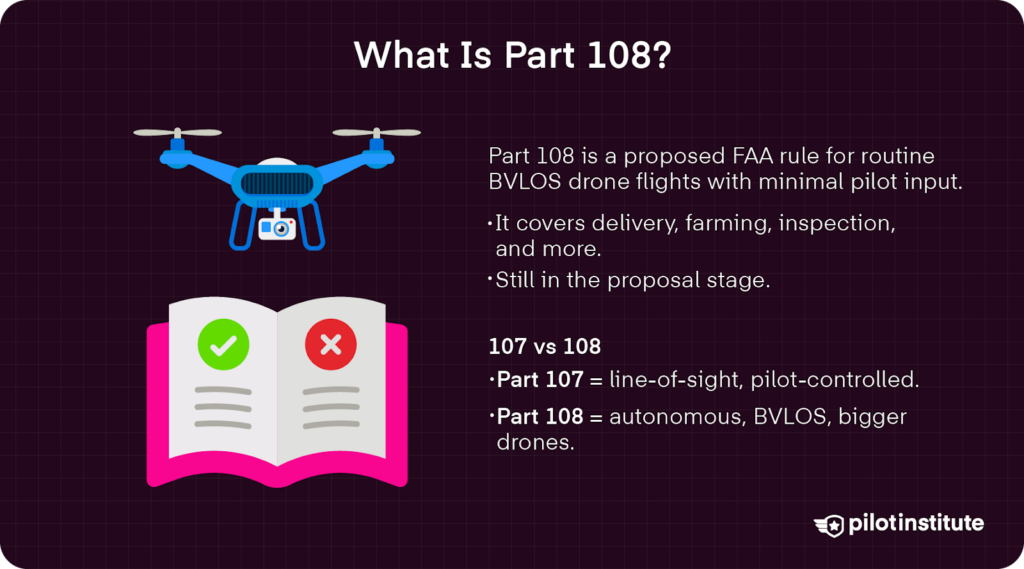
In the new 14 CFR Part 108 rules, the FAA introduced a framework to mainstream autonomous drone operations.
Simply put, Part 108 is proposed legislation that focuses on autonomous flight using beyond visual line of sight (BVLOS) operations with minimal human supervision.
Part 108 attempts to reduce the headache of seeking waivers and exemptions, instead offering a transparent, scalable, and reliable framework for conducting routine BVLOS flights in the United States.
It covers operations in agriculture, infrastructure, inspection, logistics, photography/videography, surveying, or recreational purposes.
This legislation is in the NPRM phase; the FAA has not announced a final effective date.
The Difference Between Part 107 and Part 108
Part 108 is not interchangeable with Part 107, which focuses on operations conducted by an individual remote pilot.
Rather, Part 108 focuses primarily on autonomous BVLOS flight, often involving larger drones that are in a much more significant risk category than a typical UAS under Part 107.
In the Preamble of the proposed Part 108, the FAA admitted that “with the increasing autonomy of UAS, particularly those anticipated for use under this proposal, the role of the pilot has and will continue to decrease.” Consequently, Part 108 elevates automated systems to play a significantly more significant role in modern flight operations.
Part 107 continues to govern operations that focus on visual line of sight (VLOS).
Regulatory Changes Connected to Part 108
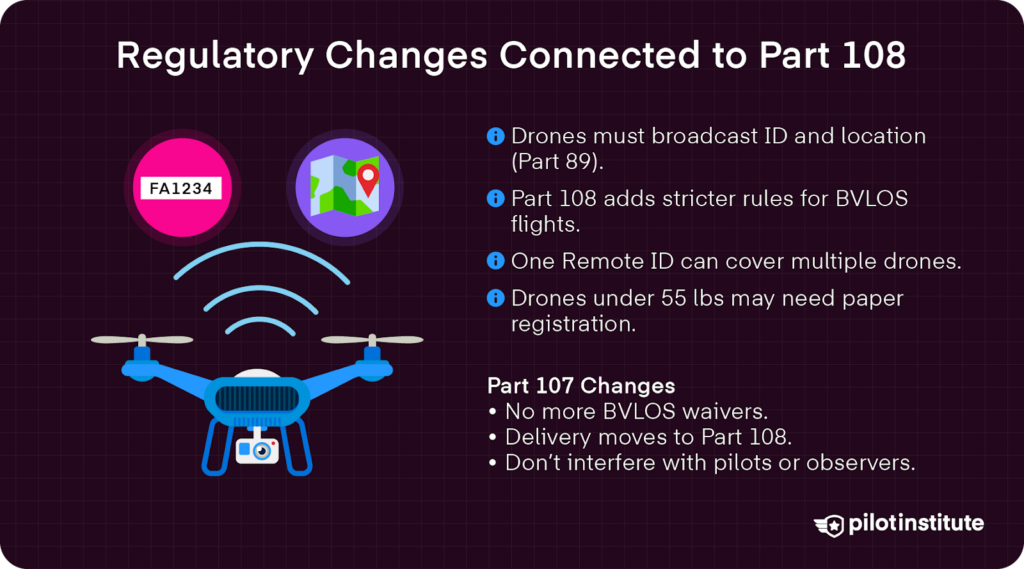
Part 89 (Remote ID) Requirements
14 CFR Part 89 sets Remote ID requirements for drones, requiring them to broadcast their registration and location information while flying. Think of it as a digital license plate.
Under Part 108, drones operating BVLOS will also need to meet RemoteID requirements.
Part 108 builds on this existing foundation, specifying the technologies and protocols for more advanced operations, helping the FAA standardize safety procedures in this new environment.
Part 48 (Registration) Updates
Traditionally, 14 CFR Part 48 governed the registration of UAS, allowing for only one Remote ID per registration.
Part 108 provides a pathway to utilize one Remote ID module for multiple drones, as long as the name, address, email address, and phone number remain the same on all registration applications.
Yet, Part 108 would also alter registration processes. Even drones under 55 lbs would need to use the paper-based process in Part 47.
What No Longer Applies to Part 107
Part 108 alters sections of Part 107 itself. Most importantly, you can no longer apply for BVLOS waivers as a Part 107 Certified Pilot, according to §107.205.
Commercial drone delivery operations have also been removed from Part 107, as they will be governed by Part 108 regulations.
Additionally, §107.10 adds new language that prohibits interference with a remote pilot in command (RPIC) or a visual observer (VO).
Key Players and Roles
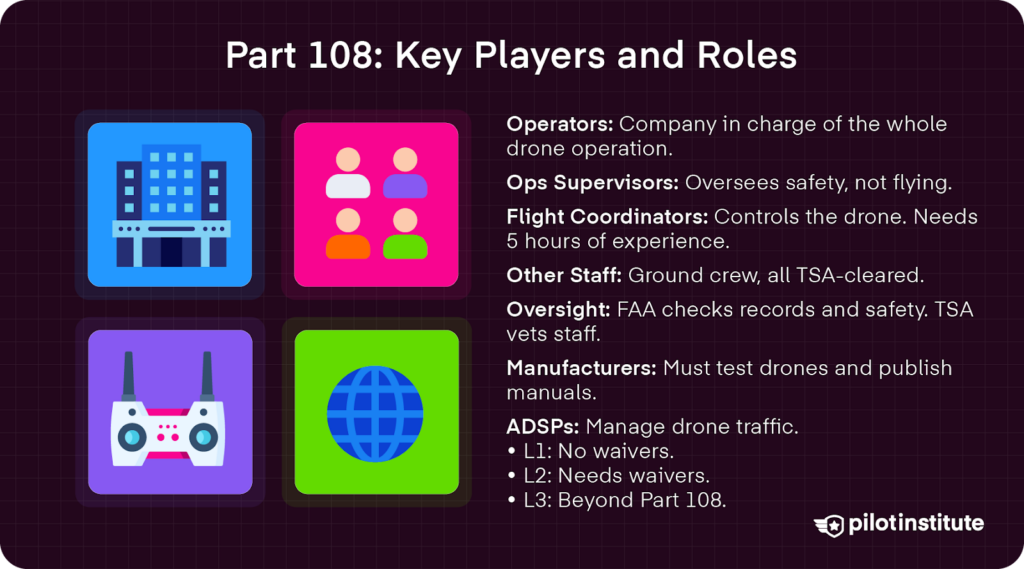
Operator
The Operator is the person, or more often, the company, that is responsible for the drones operating under Part 108.
This is part of the FAA’s new strategy to shift responsibility for enforcement and compliance from itself to Operators.
Approved Operators must fill the required operations personnel roles, including the Operations Supervisor and Flight Coordinator.
Operations Supervisor
Part 108 operations require the designation of an Operations Supervisor (§108.35) to be responsible for the overall safety and logistics of the flight operation.
Similar to a chief of operations role, an Operations Supervisor is the person who is “directly responsible for and the final authority as to the safe and secure operation of all unmanned aircraft,” according to the FAA.
Operations Supervisors are qualified through three pathways: training, experience, or expertise. Depending on the scale and nature of the operation, Operations Supervisors may be required to hold various permits or certificates.
These qualifications are not explicitly certificated by the FAA. Instead, it is the responsibility of the Operator to ensure that Operations Supervisors are appropriately qualified.
Yet, the Operations Supervisor is not the one who is directly engaging with the aircraft.
Flight Coordinator
It is the Flight Coordinator (§108.310) who actually has “tactical oversight” of the aircraft. The Flight Coordinator functions very much like a traditional Pilot in Command role, yet it does not require the formal certification requirements from manned aviation.
These individuals can monitor multiple drones at once.
However, their access is limited under Part 108, thanks to Simplified User Interaction (SUI), which reduces the need for a human pilot to stay in the loop of operations.
This reinforces the idea that UAS should have automated systems and flight stability to prevent loss of flight during normal and abnormal conditions, including the ability to maintain stable flight, regardless of external forces, like weather or equipment failure.
Flight Coordinators must have at least five hours of operating experience with the specific make and model UAS being used. This flight time must be obtained under the supervision of a qualified coordinator or Operations Supervisor.
Additionally, Flight Coordinators must retain at least five hours of flight time on specific drones within 12 calendar months to stay current.
Other Operational Staff
In §108.300, the FAA suggests additional operations personnel, depending on the unique scope of operations.
Such additional personnel may be required for safe operations, including UA maintenance and alterations, ground handling, loading and unloading of the UA, and servicing and upkeep of systems.
Other personnel may be added to establish flight paths, emergency procedures, and other operational parameters.
All personnel must receive TSA approval, including a background check.
FAA & TSA Oversight
Due to the higher-risk nature of BVLOS operations, the FAA is taking a much more significant role in evaluating and overseeing flight operations under Part 108, especially for Certificated Operations.
Moreover, the FAA is expanding its record and data reporting requirements. Recordkeeping and reporting of safety events, near-misses, etc., will be required, so the FAA can monitor operator performance over time.
As more operational data is collected (including possibly personally identifiable information of operators or third parties), the FAA is setting up mechanisms (via a Privacy Impact Assessment) to ensure data protection, transparency, and accountability.
TSA is also expanding its role within drone operations under Part 108. As stated earlier, operations personnel must be cleared by TSA. Top personnel, such as Operations Supervisors and Flight Coordinators, will be vetted by TSA’s Security Threat Assessments (STAs).
TSA will also be involved in approving the safety and security programs that Operators are required to implement.
In the expanded data and documentation reporting procedures, TSA will also have access to audit, inspect, and enforce compliance under Part 108.
Manufacturers
Despite the increased oversight from the FAA and TSA, Part 108 places much more responsibility on manufacturers as well.
The manufacturers of UAS are expected to publish detailed manuals that define and limit the acceptable operations for individual drone models (§108.720).
Additionally, new compliance rules are being placed on manufacturers. For example, under §108.735, manufacturers must test and inspect each UAS in their fleet.
Automated Data Service Providers (ADSP)
Part 146 is a newly proposed framework that regulates Automated Data Service Providers (ADSP), which was formerly referred to as third-party service providers or UTM service providers.
Their purpose will be to supply key services, like traffic management, strategic deconfliction, and conformance monitoring to Operators.
Each UAS may be composed of different ADSPs focusing on one unique component of the required practices, or these may be vertically integrated within the Operator.
According to §146.110, Level 1 ADSPs provide services that support Part 108 operations but do not rely on regulatory relief.
Level 2 ADSPs also support Part 108 operations, but do rely on regulatory relief.
Level 3 ADSPs support operations beyond Part 108.
New Terms and Core Concepts
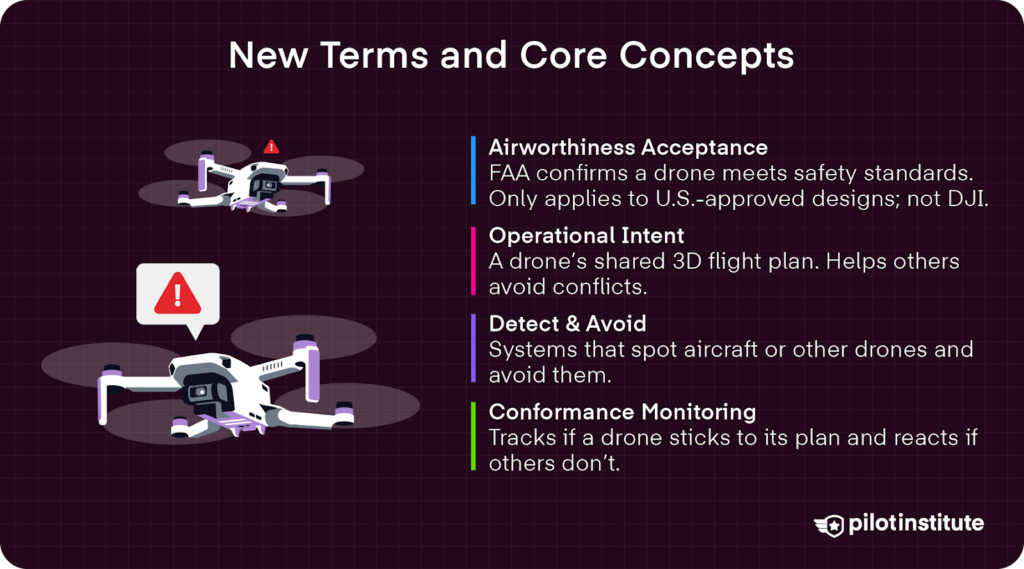
Airworthiness Acceptance
Airworthiness Acceptance is the FAA’s formal recognition that a specific unmanned aircraft or system design meets the minimum safety and performance requirements needed for its intended operations.
To qualify, manufacturers must have a safety bulletin, as well as implement a safety program. Manufacturers must provide unrestricted FAA access to their facilities, data, and documentation upon request.
This differs from the traditional Airworthiness Certificate, as manufacturers will need to submit a Means of Compliance for Review. Upon approval, manufacturers will receive a Declaration of Compliance to achieve Airworthiness Acceptance (§108.715).
As of now, the proposed legislation only offers Airworthiness Acceptance to companies operating within the United States or within countries that have bilateral airworthiness agreements for unmanned aircraft with the U.S. This means DJI drones would not be applicable for Airworthiness Acceptance, restricting them from Part 108 BVLOS operations.
Operational Intent
Operational intent is the information a UAS operator shares about a planned or active flight that describes where, when, and how the operation is expected to occur. It communicates the operator’s planned use of the airspace so others can anticipate and avoid conflicts.
The term refers to the representation of airspace in a 3D outline that is defined by one or more connected volumes of airspace with specific start and end times.
It includes details such as the planned flight volume, timing, and relevant constraints that other airspace users and service providers can use for deconfliction.
Detect-and-Avoid and Strategic Conflict Detection
One of the most important components of Part 108 is the need for enhanced collision avoidance technologies and procedures.
Detect-and-avoid systems allow drones to see, or detect, aircraft and other obstacles, then use automated processes to avoid them.
Meanwhile, strategic conflict detection identifies overlapping operational intents among unmanned aircraft. This allows the UAS to resolve such overlapping intents and avoid collisions.
Both empower UAS to detect and resolve conflicts with other drones or manned aircraft in their flight paths.
Target Average Conformance and Conformance Monitoring
This refers to the process of tracking how well an operator follows their planned flight operations over a set period of time.
Conformance monitoring under §108.5 is the real-time ability to determine whether an aircraft is flying in accordance with its operational intent. Drones flying under Part 108 must be able to determine whether an approaching aircraft is flying normally according to its plan, or if it is deviating.
When deviations are detected, the UAS must adjust and take appropriate maneuvers to avoid a collision.
Operations and Personnel Requirements
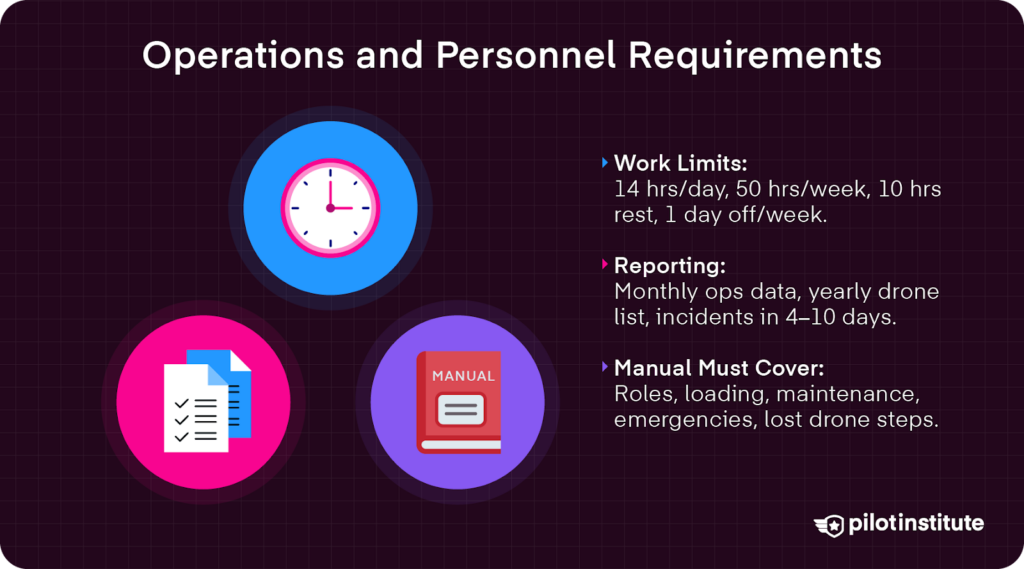
Duty/Rest Rules (§108.330)
Part 108 also outlines key work requirements for operational personnel that define duty and rest requirements.
Personnel can work a maximum of 14 hours a day, 50 hours a week.
There is also a required rest period of 10 continuous hours every 24 hours and a minimum of one day off per week.
Recordkeeping & Reporting Requirements (§108.45)
Operators must report aggregate flight data at least once each calendar month. Separately, they must report to the FAA the registration and serial numbers of all UAS used in operations at least once every 12 calendar months.
Emergency deviations and event reporting must occur within 10 days. Security occurrences need to be reported within 4 days (96 hours). Any interruption summaries must be provided no later than the end of the 10th day of the following month.
Additionally, §108.725 requires manufacturers to establish and maintain a flight-data collection system and retain flight data for at least 2 years, providing that data to the FAA upon request.
Operations Manual
The company operations manual must outline the number of operations personnel and the defined roles, along with compliance strategies for recordkeeping and reporting requirements.
Additionally, the manual must define preflight weight, loading procedures, how to estimate and communicate UAS condition, UAS maintenance procedures, and inspection criteria.
Under §108.720, manufacturer manuals must publish operating instructions, such as procedures and limitations, designed operations, the ratio of UA to Flight Coordinator, and the required parts needed.
In terms of reporting and safety, the manual must outline accident notification procedures, emergency procedures, retrieval procedures for lost UAS, and procedures for identifying and disposing of hazardous materials.
Right-of-Way Rules
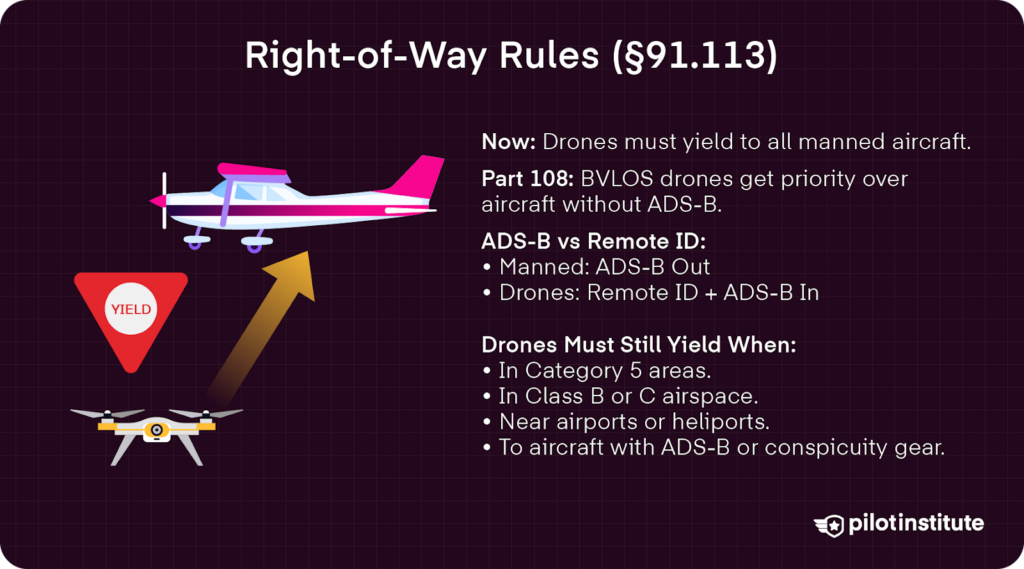
Part 108 proposes some major changes to low-altitude right-of-way rules that currently live in 14 CFR 91.113.
Many manned aircraft already broadcast their position with ADS-B Out, while Part 108 drones would rely on Remote ID and onboard sensors to know where other traffic is. Part 108 would require BVLOS drones to listen for ADS-B and a new class of electronic conspicuity (EC) devices so they can “see” cooperative aircraft electronically. Drone pilots receive ADS-B in, which gives them information about manned aircraft in the local area.
Today, drones are at the bottom of the priority list. Under Part 107 and current 91.113, unmanned aircraft must yield to all manned aircraft and stay well clear.
Under the proposed Part 108 rules, thing change at low altitude:
- UA must yield to any crewed aircraft that is:
- Departing from or arriving at an airport or heliport.
- Operating in Class B or Class C airspace.
- Operating in a Category 5 population-density area (the highest-risk “operations over people” category in §108.185).
- Broadcasting its position with ADS-B Out that meets §91.227 or an approved electronic conspicuity device on 978 MHz UAT.
- Outside those situations, and below about 400 ft AGL where Part 108 applies, Part 108 UAS would have right-of-way over crewed aircraft that are not broadcasting ADS-B Out or EC.
In other words, a non-equipped helicopter or airplane cruising low over the countryside would be required to yield to a properly equipped Part 108 drone.
The NPRM notes that some aircraft may legally be operating without ADS-B or EC, for example, aircraft with an equipment failure or certain public or law-enforcement missions that are authorized not to broadcast.
These aircraft would still have priority around airports, in Class B/C airspace, and in Category 5 areas, but could be required to yield to Part 108 drones elsewhere.Remember that this is still a proposal, not a final rule.
The FAA has specifically asked for comments on these right-of-way changes, and groups like AOPA, EAA, and labor coalitions have pushed back hard on the idea of giving drones conditional right-of-way over non-equipped manned aircraft.
Shielded Operations (§108.205)
§108.205 proposes shielded operations, where the UAS can fly within 50 feet of a structure or obstacle without requiring additional authorization from the FAA.
This includes powerlines, substations, railroad tracks, bridges, pipelines, or any other area designated by the FAA.
Given that manned aircraft rarely fly so close to obstructions, this opens up new space for UAS to use as a buffer to avoid collisions.
It also expands opportunities for inspections, infrastructure corridors, and surveys.
Yet, UAS operators must receive permission from the owner of the infrastructure first before flying so close to it.
Population Density Categories
Operations using BVLOS flight procedures must obtain FAA approval for the specific area they are flying in. This allows a thorough FAA evaluation of the given area and its potential obstacles before BVLOS operations are approved.
In Part 108, the FAA created five categories of population density that will be used to impact operational limits and permissions.
| Category | Definition | Restrictions |
| Category 1 | Further than 1 statute mile from a group of 10 people or more. | Must be conducted 50 feet from non-participants. |
| Category 2 | Within 1 statute mile of a group of 10 people or more. | Cannot use radio links certified under 47 CFR Part 15, which requires different spectrum allocation. |
| Category 3 | Within 1 statute mile of a group of 25 people or more. | Must meet Category 2 Operations and conduct the operation using the approved method for “strategic deconfliction.” |
| Category 4 | Within ½ mile of a group of 100 people or more. | Must meet Category 3 Operations and hold an operating certificate. |
| Category 5 | Within ½ mile of a group of 2,500 people or more. | All aircraft must avoid operating where it could create a hazard to people on the ground AND meet Category 4 operations, while ensuring all aircraft involved are able to automatically detect and avoid noncooperative aircraft. |
Permitted vs. Certificated Operations
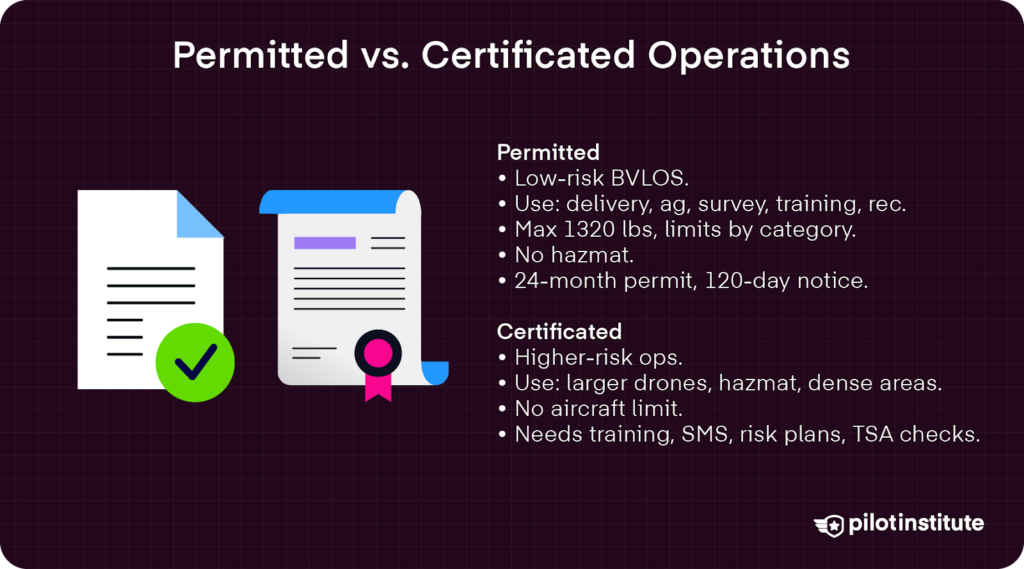
Permitted Operations
Permitted operations are designed for simpler, low-risk BVLOS operations. This includes small package deliveries, agricultural flights, aerial surveys, civic interest operations, training, and recreational flying. There is one permit per flight operation, except for test permits.
In permitted operations, there are no hazardous materials allowed onboard, as defined by 49 CFR 171.8, unless operating in accordance with 49 CFR 176.9(b).
These permits are valid for 24 months. All new permit applications must be submitted at least 120 days in advance.
Permits are available for the following:
| Permitted | Max # of Aircraft | Details |
| Package Delivery (§108.440) | 100 | 55 lbs. < Category 3. ● Must provide instructions to customers about delivery methods and how they can remain clear of the aircraft. ● Anyone involved in acceptance, rejection, handling, storage, packaging of company materials, or loading must receive initial and recurrent training on the recognition of hazardous materials every 24 months. |
| Agriculture (§108.445) | 10 | 1320 lbs. Category 1. ● Used for aerial seeding, dusting, spraying, fertilizing, crop improvement, or pest control. ● No Part 137 certification required. ● Limitations under the Federal Insecticide, Fungicide, and Rodenticide Act. ● Must have a training program tailored to their operations. |
| Aerial Survey (§108.450) | 25 | 110 lbs. < Category 3. ● Used for photography, videography, mapping, inspecting, or patrolling. |
| Civic Interest (§108.455) | 25 | 110 lbs. < Category 3. ● Used for forest/wildlife conservation, wildfire recovery, and tracking climate change. ● Also, for operations to support public safety, such as emergency or disaster responses (operators must coordinate and deconflict operations with local law enforcement or government agencies). ● It can fly at a higher population density in cases of emergency. ● A government contract is required. ● It is not intended to replace the Certificate of Authorization waivers (COA) currently issued to public agencies to operate drones in ways that are typically restricted. |
| UAS Training (§108.460) | 10 | 1320 lbs. Category 1. ● For training purposes. |
| Demonstration (§108.465) | 50 | 110 lbs. < Category 2. ● For air races, sales demonstrations, or exhibitions. ● Must be at least 500 feet away from nonparticipants. |
| Flight Test (§108.470) | n/a | 1320 lbs. Category 1. ● Used for flight tests of new UAS designs, modifications, or other development. ● Only applicable for manufacturers qualified under Subpart G or accredited educational institutions. ● No airworthiness acceptance needed. |
| Recreational (§108.475) | 1 | 55 lbs. < Category 3. ● Used for noncommercial operations and recreational flights. ● The maximum distance is 10 nautical miles from the flight coordinator. ● Does not require a company operations manual, 5 hours of operating experience, a base of operation, an operations supervisor, cybersecurity provisions, and duty/rest requirements. |
Certificated Operations
These are higher-risk operations using BVLOS, typically involving larger or faster aircraft or flights over more densely populated areas. Subsequently, certificated operations are subject to enhanced FAA evaluation and oversight.
Certification requirements include a designated training program, communications and ground risk assessment, safety management systems (SMS), hazardous material training, and defined equipment procedures.
A compliant SMS features a concrete, documented safety policy, strong safety risk management processes to identify and mitigate risks, safety assurance mechanisms, and an overall promise of safety promotion.
Part 108 often removes the limitations on the maximum number of aircraft allowed in a single operation.
Yet, certificated operations do not include training, development, testing, or recreational operations. They do include:
| Certificated | Details |
| Package Delivery (§108.440)/ Hazmat (§108.570) | 110 lbs. ● Must provide instructions to customers about delivery methods and how they can remain clear of the aircraft. ● Must have a TSA Limited Security Program under 49 CFR 1544.101. ● Anyone involved in acceptance, rejection, handling, storage, packaging of company materials, or loading must receive initial and recurrent training on the recognition of hazardous materials every 24 months. ● Must ensure the item being delivered is secure. |
| Agriculture (§108.445) | 1320 lbs. < Category 3. ● Used for aerial seeding, dusting, spraying, fertilizing, crop improvement, or pest control. ● No Part 137 certification required. ● Must have a training program tailored to their operations. ● No dispensing materials over people. |
| Aerial Survey (§108.450) | 1320 lbs. < Category 4, if more than 110 lbs. ● Used for photography, videography, mapping, inspections, or patrolling. ● If the aircraft is over 110 lbs, then the aircraft is limited to Category 4 or lower. |
| Civic Interest (§108.455) | 1320 lbs. < Category 4, if more than 110 lbs. ● Used for forest/wildlife conservation, wildfire recovery, and tracking climate change. ● Also, for operations to support public safety, such as emergency or disaster responses (operators must coordinate and deconflict operations with local law enforcement or government agencies). ● Can fly at a higher population density in cases of emergency. ● If the aircraft is over 110 lbs, then the aircraft is limited to Category 4 or lower. |
Aircraft Design & Safety Requirements
Part 108 defines several new aircraft design and safety requirements that govern the size, weight, speed, lighting, redundancy, and other requirements.
| Rule | What it Covers | Details |
| §108.805 | Limitations on Size, Weight, and Speed | UAS can have a wingspan no greater than 25 feet, weigh no more than 1,320 lbs, and fly no more than 87 knots ground speed. |
| §108.835 | Position Lighting | ● If the wingspan is equal to or more than 96 inches, then it must be equipped with red lights on its left side and green lights on its right. ● The FAA is proposing that it also incorporate white lights on its back or white wingtip lights facing its back. ● Additionally, the UAS should include operating instructions that prohibit night operations. |
| §108.830 | Anti-collision Lights | Anti-collision lights must be visible from 3 statute miles. |
| §108.840 | Redundant Power Generation, Storage, and Distribution Systems | No single malfunction of a UAS power generation, storage, or distribution should result in loss of flight or flight control. |
| §108.845 | Redundant Propulsion System | The loss of power or power failure of the propulsion system should not lead to the loss of flight or flight control. |
| §108.860 | Software | Software must function properly and dependably. |
| §108.875 | Cybersecurity | UAS must be protected from cybersecurity attacks or concerns. |
| §108.895 | Lighting Protection | The aircraft must be able to continue flight after being struck by lightning, OR the operating manual must prohibit flight during weather conditions that could include lightning activity. |
| §108.855 | Fire Protection | The UAS must be able to sustain static and dynamic deceleration loads without causing structural damage to the fuel or electrical system components or their attachments. |
| §108.870 | Systems and Equipment | No failure, or probable failure, should result in a hazard. |
| §108.890 | Operating Environment Conditions | The UAS must have the capability to identify and avoid environmental conditions in which it is not designed to operate. |
Maintenance and Repairs
§108.625 states that all repairs and alterations must be done in accordance with the manufacturer’s approved process.
Operators are expected to keep detailed maintenance records under §108.40.
Yet, §108,625(b) asserts that the simple replacement of parts with identical or alternative parts, such as replacing a propeller, will not be considered a repair or alteration.
However, under §108.615, there are some exclusions, including life-limited parts. Operators must track all life-limited parts, and any expired parts must be removed from the UAS and destroyed.
Testing & Quality Assurance
Under Part 108, unmanned aircraft must undergo developmental testing (§108.930) to validate design and safety performance, followed by at least 150 flight hours of function and reliability testing to prove consistent operation.
Manufacturers are also required to establish robust quality assurance systems (§108.730) to maintain production standards, with ongoing production inspections (§108.735) ensuring each aircraft continues to meet the FAA’s accepted safety and reliability benchmarks.
Future FAA Rulemaking
Along with all the changes proposed in Part 108, there are additional unmanned aircraft flight restrictions that have not yet been written.
Part 74 (§108.220) is expected to be released later in 2025. This section will be related to §2209 of the 2016 FAA Reauthorization Act, which directed the FAA to establish procedures allowing certain fixed-site facilities, such as critical infrastructure, energy production sites, and other sensitive locations, to request and receive airspace restrictions specifically aimed at unmanned aircraft operations.
Many expect these future FAA rules to create areas where drones will not be able to operate, adjusting the UAS airspace designations seen in FAA Order JO 7400.
Conclusion
Ultimately, Part 108 shifts BVLOS from exemptions to a scalable framework. The proposed legislation paves the way for delivery, agriculture, infrastructure, and civic drone applications using BVLOS.
It also moves responsibility from individual pilots to organizations.
Future regulations, expected soon, will continue to shape the BVLOS ecosystem. Stay ahead of the curve with Pilot Institute as we continue to publish updates and insights on Part 108 and future FAA drone rules as the BVLOS ecosystem evolves.
